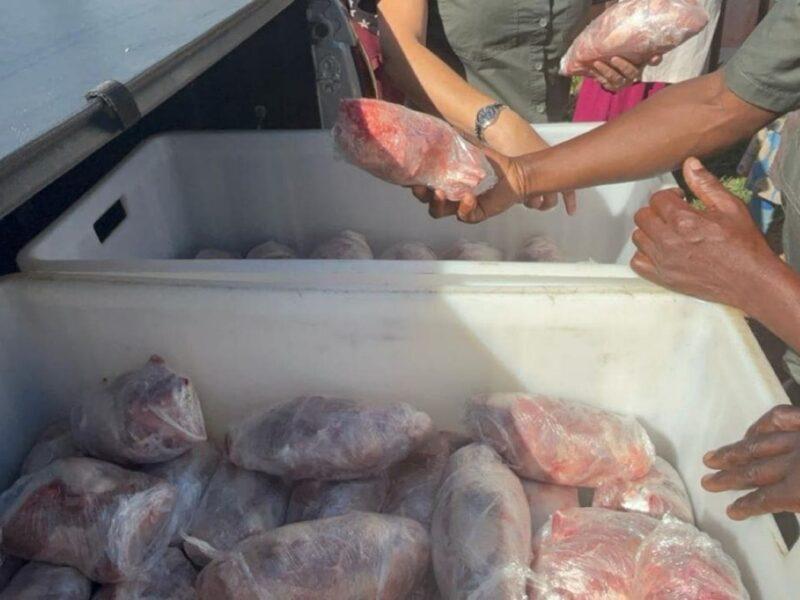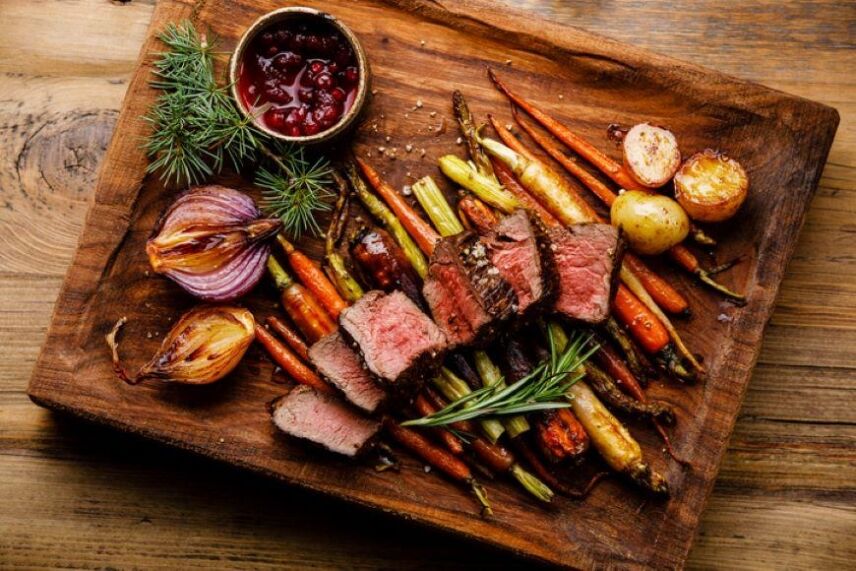If you know anything about South Africans, it is that we love our meat. Whether it is braaied (which is preferable!), stewed, roasted, fried, or dried we will be there to enjoy it. As I write this blog, South Africa’s Springboks are preparing to face Wales at Twickenham this afternoon in a much-anticipated rugby match and, as current Rugby World Champions, South Africans far and wide are eager to see their team in action. And yes, I am referring to the Springboks rugby team, not the Springbok antelope!
South Africans love their rugby as much as their braais. These two go together like the American’s peanut butter and jelly sandwiches, and I am therefore not surprised that the two butchers I visited this morning had their stock of biltong and droewors depleted. These are, of course, great traditional rugby snacks. What are biltong and droewors you might ask? Read on to find out!
On a positive note, I did manage to secure some great kudu steaks that I plan on braaiing later this afternoon during the match. However, I digress…let’s get back to hunting in South Africa and the tempting game meat options on offer.
[DYNAMIC-BLOGTABLEOFCONTENT]
Hunting in South Africa
Hunting in South Africa is the dream of many a hunter. And while the African hunt allows for superb trophies and an exciting game hunting experience, the cuisine does deserve a notable mention. And no, I am not only referring to the international cuisine options offered on a hunting safari but rather the range of cuisines prepared using the game meat harvested during sport or game hunting adventures.
What is Game Meat?
Game meat is the meat of any bird or animal traditionally hunted for either sport or traditionally hunted and not raised on a farm under controlled circumstances. Many hunters or non-hunters may ask what happens to the meat harvested during the South African hunting trip. While some meat may be taken for guests to taste and enjoy tasting the game meat, it is more often than not donated to the local community.
The Khoi and San are believed to be the first inhabitants of Southern Africa, between 30,000 – 40,000 years ago and these hunter-gatherers and hunters hunted in the area to provide for their families. The San were very industrious and used all parts of the animals that were killed, making sure that nothing was wasted. The meat was eaten, the fur was used for clothing or decoration, the fat was rubbed over their body as a sign of wealth, and the bones were used as tools, decorations, and sometimes even incorporated into their dwellings.
Nowadays, many South Africans still hunt (some poaching illegally) to provide for their families. I can remember many years ago the excitement that the June and July winter school holidays would bring, as my best friend would go game hunting in the Karoo. His family had a sheep farm in the Eastern Cape, and they would enjoy hunting adventures in the area, hunting huge kudu, and bringing the processed meat home for the family freezer. The best part? There would always be plenty of droewors and biltong to enjoy afterward!
Feeding and Supporting Local Communities
You may ask if hunting in South Africa assists local communities and if are there opportunities to “give back” to these aforementioned areas and regions. The answer is a resounding yes,
South Africa has a large unemployment rate, sitting at a whopping 32.9% for the first quarter of 2024. There simply aren’t sufficient employment opportunities for individuals seeking work and trying to support their families. While some unemployed urban dwellers may be lucky enough to find “piece jobs” meaning a job once or twice a week, they are the “lucky” ones and many communities in rural areas don’t have these opportunities. While some of the locals may be employed as trackers, skinners, cleaners, or otherwise involved in the hunting industry, unemployment is rife, and the need for food, especially protein, is overwhelming.
And this is where hunters and the hunting community manage to give back and assist. Meat that is hunted on an African hunt is often donated to these communities, providing vital protein and food to the impoverished people in the area. From bush pigs, and warthogs, to larger antelopes, nothing goes to waste.

Supplying Local Markets
South Africa also has a growing network of game farms and hunting ranches that supply the local markets with game meat. From high-end Woolworths to the local butchery, game meat is becoming more noticeable with its inclusion in local supermarket chains. Not only is it more affordable than several other cuts of meats, but it is also seen as a healthier red meat option for South Africans who love their braais.
What Type of Game Meat is Most Popular in South Africa?
South Africa is home to a range of game meat items with popular game meat being impala, kudu, springbok, wildebeest, warthog, eland, oryx, and ostrich.
Although the prime game hunting season in South Africa is during the cooler months of May and August, many species are available to hunt throughout the year, except during mating season. This allows a variety of both African hunts and therefore meat options to enjoy for game hunting enthusiasts.

Is Game Meat Healthy to Eat?
Yes, the health benefits of consuming game meat include:
- Good source of lean protein
- Lower in calories and fat than other meat types
- Full of vitamins and minerals, including Omega 3 and 6
- Great tasting
- Organic and free of medications and added hormones
What Type of Dishes or Foods can You prepare with Game Meat?
In many instances, game meat is much like any other meat and a variety of meals can be enjoyed. Game meat, also called venison, can be prepared in many ways, using a tantalizing array of spices to enhance the flavor of the meat.
Biltong
Biltong is a South African delicacy, enjoyed by both young and old. It is dried, cured meat that is air-dried with lots of spices, including coriander, which gives it a unique and distinct flavor.
Biltong is made from a variety of meats, with popular choices being kudu, springbok, oryx (gemsbok), and ostrich.
Droewors
Another South African delicacy, droewors is air-dried sausage, using a variety of spices to flavor it. It was traditionally made from beef, but venison droewors is also very popular, although at times not as widely available as beef droewors.
Braai
South Africa is synonymous with braaiing and many people would enjoy a braai every week if the budget and weather allows!
Popular game meat options for braaiing include:
- Kudu steaks or sosaties
- Warthog sausages or chops
- Crocodile Fillet
- Ostrich Fillet
There is something about the taste of food cooked over an open fire…the smell of the meat cooking, the sizzle of the fat as it hits the hot coals, that nothing can compare to. A personal favorite of mine is an ostrich fillet marinated in red wine and garlic, seared over hot coals, and served with a traditional “braaibroodjie.”
A braaibroodjie is a traditional accompaniment to a braai and can be as simple, or intricate, as you would like it to be. A braaibroodjie is a toasted sandwich, toasted over the coals, and traditionally includes cheese, tomato, and onion, together with chutney. You can get fancy and add more ingredients, but sometimes simple is best, especially when enjoyed with some juicy and flavoursome braai meat.
Braais can happen anywhere, at home in a built-in braai, on the beach in areas where it is allowed, or even in the middle of the bushveld, as shown here below where some tasty game sausage is enjoyed during a game hunting adventure in Limpopo.
Potjiekos
You don’t get more traditional than potjiekos. A potjie is a type of stew that is cooked in a three-legged pot over open flames or coals. It consists of meat and vegetables and is mcooked slowly over a couple of hours for the flavors to develop. Ingredients are layered in the pot and the idea is not to stir the pot and only lift the lid when needed. Potjie is usually served with rice, pap, or traditional pot bread that is also prepared on the fire.
Game meat that is used for potjie includes all types of venison, such as kudu, eland, impala, and springbok, as well as warthog.
Sausage (wors)
Once again, South Africans are big on sausage. Whether it is droewors as above, or traditional “wors” that we can pop onto a braai for some quick wors rolls, nothing beats this tasty meaty treat. It can be made from a variety of game meats, such as kudu, impala, wildebeest, or springbok to name but a few, but the important thing to remember when preparing or braaing this, is not to dry the wors out, but to cook it to perfection!
Warthog sausage and cheese grillers are very popular choices for processed sausages and can also be beautifully prepped and enjoyed on the braai.
Soups
Venison can be used to make a thick, chunky vegetable soup full of flavor and goodness, just perfect for the colder winter months and most enjoyable during African hunts.
Another tasty option that is often enjoyed on a hunting safari is biltong soup, a rich creamy, and delectable soup made with biltong, that brings together the flavors of South African cuisine at its best.
Carpaccio
Springbok or kudu carpaccio is a delicacy that is well worth enjoying. Do yourself a favor and indulge if the opportunity ever arises!
These are just a few of the popular dishes created with game meat, other options include venison pies, curries, stews, and many more.
South African Desserts
South Africa is a nation that loves socializing and entertaining and we are blessed to enjoy a favorable climate to allow this. Most events or meals will end with tasty desserts, more often than not homemade, and certainly not weigh-less approved.
Some traditional desserts that you will find in many homes across South Africa to enjoy include:
- Malva Pudding – A traditional baked pudding served warm with custard or ice cream
- Peppermint Crisp Tart – A sweet fridge tart using layered biscuit, peppermint crisp, and caramel filling.
- Milktart – This is a custard-type tart served in a crust, sprinkled with cinnamon. Other variants include a baked milktart, as well as a crustless version.
- Koeksister – A traditional dessert made from dough, deep fried, and dipped into a thick, sweet syrup. Sometimes covered in coconut. Tip: Try eating them straight from the fridge or freezer, totally delectable!
South Africa: A Melting Pot of Traditional Culinary Experiences
Bottom line: Our rainbow nation is a melting pot of heritage, cultures, cuisines, and experiences that collate to offer visitors to our shores the very best of South Africa, including food. While hunting in South Africa, you will have the opportunity to enjoy a large variety of many South African traditional dishes, with some using the game meat harvested from hunting adventures in the area. Taste them, enjoy them, and once your African hunting adventure is complete, and you have returned home, think back fondly of the mouthwatering game meats you harvested and enjoyed on your African hunt.
Lastly, I am pleased to share that the Springboks won the rugby, and the kudu steak was tender, juicy, and full of flavor!
Author: B. Hershensohnn
